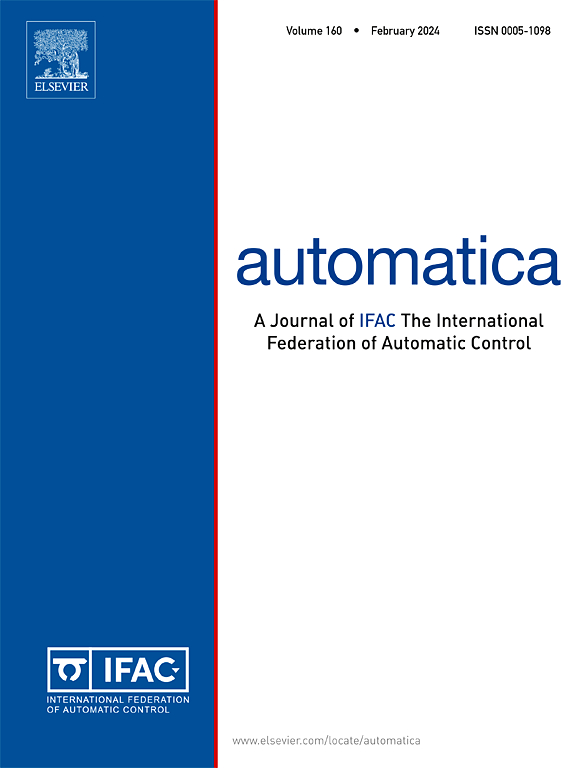连续网络定位的性能优化
IF 4.8
2区 计算机科学
Q1 AUTOMATION & CONTROL SYSTEMS
引用次数: 0
摘要
传感器网络线性定位技术的最新进展使传感器能够利用传感器之间的测量数据(如距离、方位和内角)进行自我定位。根据早期的研究,线性定位算法的性能相对较差,但现有文献尚未充分解决这一问题。本文旨在提高线性和连续定位算法的性能。更具体地说,我们将重点放在提高线性定位算法性能的三个关键方面,即稳定裕度、收敛速度和对测量噪声的鲁棒性。首先,我们提出了不同测量类型下网络线性定位算法的统一描述,并证明线性定位算法的稳定裕度、收敛速率和鲁棒性通常由一个参数决定,即网络定位矩阵的最小特征值。其次,通过精心选择决策变量,我们将性能优化问题表述为特征值优化问题,并证明了特征值优化问题的无差异性。第三,我们提出了一种分布式优化算法,它能保证收敛到特征值优化问题的最优解。最后,仿真实例验证了所提分布式优化算法的有效性。本文章由计算机程序翻译,如有差异,请以英文原文为准。
Performance optimization for continuous network localization
Recent advances in linear localization of sensor networks allow sensors to localize themselves by using inter-sensor measurements, such as distances, bearings and interior angles. According to earlier works, linear localization algorithms’ performance is relatively poor, which, however, has not been adequately addressed in the existing literature. The aim of this paper is to improve the performance of linear and continuous localization algorithms. More specifically, we focus on improving three key aspects of linear localization algorithms’ performance, i.e., the stability margin, convergence rate and robustness against measurement noises. Firstly, we propose a unified description for networks’ linear localization algorithms, given different types of measurements, and show that the stability margin, convergence rate and robustness of linear localization algorithms are commonly determined by one parameter, namely, the minimum eigenvalue of the network’s localization matrix. Secondly, by carefully choosing the decision variable, we formulate the performance optimization problem as an eigenvalue optimization problem, and show the non-differentiability of the eigenvalue optimization problem. Thirdly, we propose a distributed optimization algorithm, which guarantees the convergence to an optimal solution of the eigenvalue optimization problem. Finally, simulation examples validate the effectiveness of the proposed distributed optimization algorithm.
求助全文
通过发布文献求助,成功后即可免费获取论文全文。
去求助
来源期刊

Automatica
工程技术-工程:电子与电气
CiteScore
10.70
自引率
7.80%
发文量
617
审稿时长
5 months
期刊介绍:
Automatica is a leading archival publication in the field of systems and control. The field encompasses today a broad set of areas and topics, and is thriving not only within itself but also in terms of its impact on other fields, such as communications, computers, biology, energy and economics. Since its inception in 1963, Automatica has kept abreast with the evolution of the field over the years, and has emerged as a leading publication driving the trends in the field.
After being founded in 1963, Automatica became a journal of the International Federation of Automatic Control (IFAC) in 1969. It features a characteristic blend of theoretical and applied papers of archival, lasting value, reporting cutting edge research results by authors across the globe. It features articles in distinct categories, including regular, brief and survey papers, technical communiqués, correspondence items, as well as reviews on published books of interest to the readership. It occasionally publishes special issues on emerging new topics or established mature topics of interest to a broad audience.
Automatica solicits original high-quality contributions in all the categories listed above, and in all areas of systems and control interpreted in a broad sense and evolving constantly. They may be submitted directly to a subject editor or to the Editor-in-Chief if not sure about the subject area. Editorial procedures in place assure careful, fair, and prompt handling of all submitted articles. Accepted papers appear in the journal in the shortest time feasible given production time constraints.
 求助内容:
求助内容: 应助结果提醒方式:
应助结果提醒方式:


